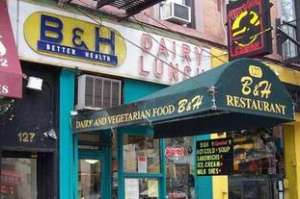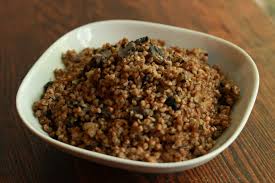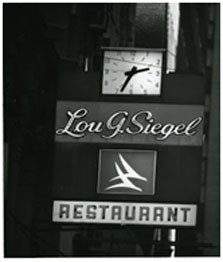Kasha (also known as buckwheat groats) is one of HG’s favorite foods. HG is always puzzled why it’s so seldom on restaurant menus (except for the rapidly diminishing number of Jewish “dairy” restaurants) and is so rarely used in home cooking. Simple to make. The kasha grains are mixed with beaten egg and sautéed until dried. A few cups of chicken broth are added to the saucepan and the mix is cooked until the grains become soft (Warning: Never overcook into a mush). HG likes kasha topped with fried onions and mushrooms (accompanied by a bowl of sour cream and plenty of ground pepper and sea salt flakes). Great topped with fried chicken livers and onions. Kasha Varnishkes used to be a staple in traditional Jewish eateries. In these kosher (non dairy) restaurants the mix of kasha and butterfly (farfalle) pasta would get an exhilarating hit of crisp fried onions and a big dollop of chicken fat. A young HG would accompany this treat with plenty of cold vodka and beer at Moe Dubiner’s eponymous non-kosher restaurant (long closed) on New York’s Stanton Street. It was a big favorite of the Jewish gangsters and gamblers who came to the restaurant for a late night snack. Kasha is versatile. Great in a big bowl of steaming chicken broth. Excellent as a filling in traditional blintzes (an egg crepe topped with kasha, rolled and then fried gently) or knishes (a flaky stuffed pastry). Best of all as an accompaniment to slow roasted beef brisket. Obligatory is lots and lots of savory gravy.
More Kasha Love
February 14th, 2015 § 2 comments § permalink
New York Nostalgia Part 3 (The Jews)
January 24th, 2014 § 0 comments § permalink
Two events, one tragic and one sad, took place in New York City some 18 years ago. For HG, these events marked the end of New York’s Jewish ambience. Sure, the New York of that time, like today, had multitudes of Italians, Irish, African-Americans, Asians, and Hispanics. But, it was the Jews who set the overall tone of the city. The tragic event took place on March 5, 1996. On that day, Abe Lebewohl, the proprietor of the original Second Avenue Delicatessen (2nd Avenue and 10th Street), was shot and killed as he delivered cash receipts to a nearby bank. Lebewohl not only ran a great Jewish delicatessen, he was also a direct link to Second Avenue’s colorful past as the home of Yiddish theater. And, he honored that past by naming one of the delicatessen’s dining rooms after Molly Picon, a Yiddish musical star (and a favorite of HG’s Mom). Wonderful Jewish delicatessens like Gitlitz (79th and Broadway) are gone. Katz’s remains on the Lower East Side — a stalwart in these lean deli times where the venerable Carnegie Deli has devolved into a grotesque tourist trap known only for the over-stuffed size of their sandwiches.
The sad event was the closing of Lou G. Siegel’s on June 29, 1996. It had been in business for 79 years. Lou G. Siegel was a distinguished and dignified restaurant in the heart of New York’s Garment Center (38th Street just west of Seventh Avenue). It was strictly kosher (there were two Rabbis on the payroll) and the food was delicious, hearty and caloric. It was where observant Jewish (were there any other?) clothing executives dined. The non-observant big shot Jews ate at Al Cooper’s, further east on 38th. The garment workers frequented Dubrow’s and the other very good cafeterias in the vicinity. They are all gone. Seventh Avenue has been named “Fashion Avenue”. The Garment Center with its rabid union members, gangsters and famed lunchtime schmooze is now the Fashion District. The habitues of Siegel’s kingdom of chicken fat and rugelach would have a sardonic laugh. Siegel’s was the best of a host of traditional kosher restaurants that served meat ( Kosher law, “kashriuth”, forbids the mingling of meat and dairy products). Some of the other restaurants of that type were Moskowitz & Lupowitz and Gluckstern’s. Sammy’s Romanian (Allen and Delancey) is a survivor. The food (non-kosher) is tasty. The prices are steep. The atmosphere is a Jewish parody, a broad dialect joke. The great, strictly dairy (and fish) Jewish restaurants (Ratner’s, Rappaport’s, Steinberg’s, Paradise) are gone although some smaller operations still exist. This is not to say that there aren’t kosher restaurants left in New York — There are plenty of them spread throughout the five boroughs, catering to a new generation of the observant and a new group of Israeli and Russian Jewish immigrants. The menus would be un-recognizable to the observant Jews of fifty years ago as they feature kosher sushi, kosher Italian and kosher Indian food (amongst others). The restaurants HG misses most are those that were not kosher and had wide ranging menus that included, but were not confined to, Eastern European Jewish food. The three greatest, of course, were Lindy’s, Reuben’s and Tip Toe Inn. Gone. New York has, for better or worse, lost much of its Jewish flavor. It is now a truly international city with a cuisine to match. No, New York is no longer Jewish but it if you are hungry it’s a great town.
The Dairy Restaurant. Hot Weather Refuge.
July 3rd, 2011 § 0 comments § permalink
 Thoughts of ice cold borscht and steamy New York weather make HG recall those refuges from the heat: Dairy restaurants. Dairy restaurants obeyed Jewish dietary laws and served only “dairy” and “pavre” food.
Thoughts of ice cold borscht and steamy New York weather make HG recall those refuges from the heat: Dairy restaurants. Dairy restaurants obeyed Jewish dietary laws and served only “dairy” and “pavre” food.
They served borscht (beet soup), schav (sorrel soup), blintzes (rolled crepes stuffed with cheese or potato) , kasha varnishkes (buckwheat groats with butterfly shaped pasta), potato pirogen (boiled potato and onion dumplings) and more. Big bowls of excellent bread, bialys, onion rolls — also called “pletzels” and copious amounts of butter. Big bowls of thick sour cream were there on the table to accompany every dish. There was fish (considered “parve” a.k.a. neutral meaning neither meat nor dairy) including many varieties of herring; tuna and sardine salads; gefilte fish with strong horse radish.
No meat. Emphatically no meat. Forbidden. A kosher enterprise could not serve both meat and dairy products.
Every Manhattan neighborhood had a Dairy restaurant (okay, not the Upper East Side). The Paradise and Steinberg’s were popular on the West Side. Ratner’s and Rappaport’s ruled the Lower East Side. Scores more in The Bronx and Brooklyn. All gone. Assimilation or changing tastes?
SJ reports only one traditional “Dairy” remains: B&H on Second Avenue. Long may it cool fevered brows and clog arteries.

